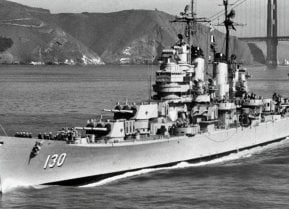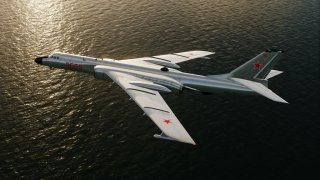Russia's Tupolev Tu-16 Bomber: A Complete History
Russia's Tupolev Tu-16 twin-engined jet-powered strategic bomber has seen combat action outside Russia's armed forces.
To Americans, the badger is a predatory mammal that proudly gives a nickname to the state of Wisconsin in general, and her flagship university’s sports teams in particular. In addition, the phrase “honey badger” has inspired memes, videos, and books that have taken on a life of their own. But in a Russian context – Soviet era and present day alike – the nickname “Badger” has a much more ominous connotation: It is the NATO reporting name for the Tupolev Tu-16 twin-engined jet-powered strategic bomber.
Birth of the Tu-16 Badger Bomber
As noted by the always handy info pages provided by the Federation of American Scientists, “The Tu-16 was designed as a high-speed jet bomber for operations in theaters close to the Soviet Union. Intended to replace the propeller-driven TU-4, the greatest challenge during development was doubling the speed to improve survivability in the face of enemy fighters.” (The Tu-4, of course, was a USSR-built plane that conveniently copied the design of the American B-29 Superfortress.)
To NATO planners, this was a not-so-honey Badger. The aircraft made its maiden flight on April 27, 1952, under the initial designation of Tu-88, but upon entering frontline service in 1954, it was redesignated as the Tu-16, with NATO assigning the reporting name “Badger-A.”
The plane was initially designed to be a high-altitude, free-fall bomber. As HotCars columnist Henry Kelsall writes:
“Most important for the Soviet Union, it could carry various nuclear weapons, or a massive FAB-9000 20,000 lb bomb, effectively the Russian version of Britain’s Grand Slam bomb used to sink the German battleship Tirpitz…The leap that the Soviet Union took with the badger was huge. They went from a copy of a four-engine, piston engine bomber, to a twin-jet powered leviathan with a huge bomb capacity…it was a massive improvement in Soviet air power and a big step for development of strategic bombers in the country. It's probably one of the most significant aircraft in Russian aviation history.”
However, just like the Tu-16’s propeller-powered comrade, the Tu-95 “Bear” bomber, the Badger proved itself to be a highly versatile and adaptable platform. Before long, the Tu-16KS-1 (“Badger-B” for NATO purposes) cruise-missile-carrying version came into being. Then came a slew of other variants, fulfilling specialized mission needs such as aerial reconnaissance, maritime surveillance, electronic intelligence gathering, and electronic warfare. The airframe was even used for civilian airliner functions with Aeroflot, under the Tu-104 redubbing.
A total of 1,507 airframes were built between 1952 and 1962. Some of these fearsome bombers were exported to the air forces of Egypt, Indonesia, and Iraq.
Tu-16 Badgers In Battle?
As far as I can ascertain, the Tu-16 was never used in real-world combat by the Soviet Union or by post-Soviet Russia.
In technothriller fiction, however, the Badger plays a prominent role in the late, great Tom Clancy’s second novel, Red Storm Rising, co-written in 1987 with former U.S. Naval Officer Larry Bond.
In one especially harrowing scene, the bombers are used to launch a devastating attack against a NATO ship convoy. If my senile old memory serves me correctly, the particular chapter wherein that scene takes places is titled “Vampires Inbound,” which is a Navy brevity phrase to indicate an anti-ship missile attack.
Outside of Soviet and Russian use, Tu-16s did see some combat action, starting with the Indonesian Air Force during 1961’s Operation Trikora, the capture of Western New Guinea (now Papua and Papua Barat) from the Dutch. The Egyptians deployed their Badgers against Israel during the 1973 Yom Kippur War, and against Libya during a 1977 border clash. Lastly, the Iraqi Air Force used the Badger for bombing raids against the Kurds in 1974, and over Tehran during the Iran-Iraq War of the 1980s. However, their Tu-16 fleet was either destroyed during Operation Desert Storm, or fell into disrepair shortly thereafter.
Beijing’s Badgers
The Russian, Egyptian, Indonesian, and Iraqi Badgers alike are now long retired. However, America and her allies haven’t heard the last of this bomber. The People’s Liberation Army Air Force began building the plane under license back in 1959, under the designation of Xian H-6. As of November 2020, China’s air force had 231 of these bombers in their arsenal, with the latest variant being the H-6N, which is capable of aerial refueling and carrying air-launched cruise missiles, thus granting the plane standoff attack capability.
If a shooting war were to break out in the Taiwan Strait – which unfortunately looks ever more likely – these Chinese Badgers would have to be taken very seriously by the soldiers, sailors, airmen, and Marines resisting an attempted invasion by Beijing.
About the Author
Christian D. Orr is a former Air Force Security Forces officer, Federal law enforcement officer, and private military contractor (with assignments worked in Iraq, the United Arab Emirates, Kosovo, Japan, Germany, and the Pentagon). Chris holds a B.A. in International Relations from the University of Southern California (USC) and an M.A. in Intelligence Studies (concentration in Terrorism Studies) from American Military University (AMU). He has also been published in The Daily Torch and The Journal of Intelligence and Cyber Security. Last but not least, he is a Companion of the Order of the Naval Order of the United States (NOUS).


